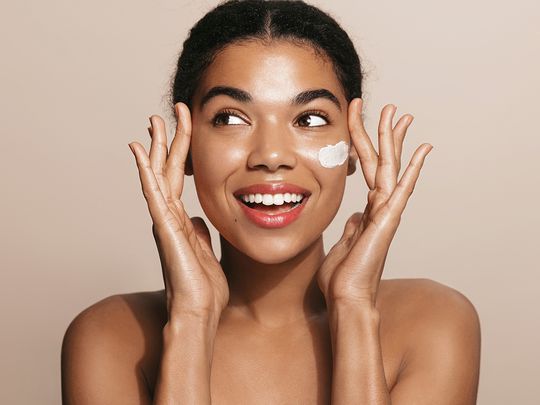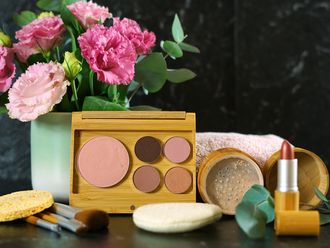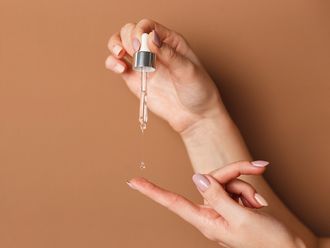
It’s the era of skincare customisation. We’re all different, so it’s no wonder a one-size-fits-all skincare regimen doesn’t work. While some of us are focusing on retinols for its anti-ageing benefits, others are looking for a solution for hyperpigmentation – where patches of the skin become darker than surrounding areas.
That’s where kojic acid comes in.
This naturally derived ingredient has historically been a key player in skin-whitening products – it has the ability to brighten one’s skin tone and fade away dark spots. These days, however, the increasingly popular ingredient is being used in appropriate concentrations to treat specific melanin-related conditions, offering a gentler alternative than ever before.
Dr Anna Zakhozha, specialist dermatologist at Hortman Clinic Dubai, gave us an in-depth overview of kojic acid-based products, and how best to use them – scroll below to read what she said.
Check out our curated list of the best kojic acid serums and creams, and become an Amazon Prime member to get free, fast delivery.
1. Best Overall: Neostrata Enlighten Pigment Lightening Gel
Target dark spots with Neostrata’s lightening gel – it visibly lightens discolouration for a more even skin tone. This gel treatment, recommended by Dr Zakhozha, is formulated with an exfoliating, 10 per cent blend of AHAs and PHAs (alpha hydroxy acids and polyhydroxy acids). It also includes one per cent kojic acid, along with vitamin C and licorice extract to brighten the skin and smooth out your complexion. Reviewers saw results within a week, when they used the product twice a day. Do note that the brand urges customers to limit sun exposure during and after application, to stop darkening from recurring.
2. Best Serum: Urban Skin Rx Even Tone Super Glow Serum
For those who are used to kojic acid in their skincare routine, it’s time to glow. Urban Skin’s serum uses an advanced strength blend of ingredients to target dark spots, ageing skin and sun damage. It includes vitamin C to boost brightness, kojic acid to exfoliate dead skin build-up, and both ferulic acid and niacinamide to tackle signs of ageing, including fine lines and wrinkles. Reviewers say the serum is ultra-lightweight and has a distinctive citrus scent.
3. Best for Underarm Darkness: Kojie San Skin Brightening Soap
Kojie San’s face and body soap bar went viral on social media recently for its transformative effects, as is obvious in the comments of over 21,000 satisfied reviewers on Amazon. This gentle, moisturising soap combines the brightening powers of kojic acid with the antioxidant, antifungal and antibacterial properties of coconut oil. Add to it the antiseptic and anti-inflammatory benefits of tea tree oil, and it’s a potent solution for people looking to fade age spots, acne blemishes and scars, or use it to lighten darker areas of the skin. The soap bar has a pleasant orange fragrance, and it’s ideal for daily use.
4. Best for Even Skin Tone: Naturium Tranexamic Topical Acid 5%
Even though Naturium’s serum is packed with potent ingredients, it’s suitable for all skin types – even sensitive skin. This formula uses kojic acid alongside niacinamide, licorice root extract and tranexamic acid to reduce discolouration, even out the skin tone and texture, and calm and support the skin barrier. It’s best to use this serum a couple of times a week, twice a day. Happy reviewers say the serum has provided visible effects, with some stating their skin has never looked better.
5. Best for Spot Treatment: PCA Skin Pigment Gel
Formulated with kojic acid, azelaic acid and antioxidants, PCA Skin’s pigment gel is well-suited for spot treatments, to promote an even skin tone. The formula is hydroquinone-free, so people with sensitive skin are not likely to have issues using it. But application does involve a learning curve since it’s quite a potent formula. Reviewers caution that it should be used sparingly – just a drop targeting each dark spot – and could be coupled with a moisturiser after application, since you might see initial flaking or peeling of the skin as it takes effect. The brand recommends using the serum at night on clean skin, limiting sun exposure and using sunscreen.
Why is kojic acid used in skincare products?
While it may seem like a novel ingredient, kojic acid, which is derived from various fungi species, can be actually be found in plenty of skincare products – from cleansers and toners to serums and masks. It’s because of its unique ability to treat dark spots and hyperpigmentation.
Dr Anna Zakhozha, specialist dermatologist at Hortman Clinic Dubai said: “Kojic acid has a lightening effect, because it inhibits melanin production by our cells. So, it’s similar to hydroquinone, but with fewer side effects.”
A powerful antioxidant that helps the skin cells repair themselves, kojic acid has the ability to stop abnormal or excessive pigment production in its tracks, while also fading existing discolouration. Dr Zakhozha added: “It can lighten [skin that has suffered from] sun damage, age spots and scars, and it can be used as an anti-fungal and antibacterial ingredient.”
Who can benefit from kojic acid-based skincare?
The main advantage of kojic acid is that it helps even out the skin tone and addresses hyperpigmentation. Since it has antimicrobial properties, it also helps reduce the intensity of breakouts, and brightens dark spots caused by pregnancy hormones and any post-inflammatory hyperpigmentation (PIH) from acne.
Dr Zakhozha said: “People with darker skin tones will benefit from kojic acid more, as they have a higher concentration of melanin in their bodies. Also, people with oily, or dry and sensitive skin will [see results].”
According to our expert, it’s best to opt for products with one per cent of kojic acid, although you can find it in concentrations of up to four per cent. Starting off with a lower concentration is best, since higher doses can produce unintended results. Dr Zakhozha cautioned: “Some individuals may experience some side effects from it, like dermatitis, redness and inflamed skin.”
Our expert advised applying it twice daily, after washing the face. Remember to do a patch test when using it for the first time, and to regularly apply sunscreen.
Our recommendations are independently chosen by Gulf News editors. If you decide to shop through links on our website, we may earn an affiliate commission, as we are part of Amazon Services LLC Associates Program.











